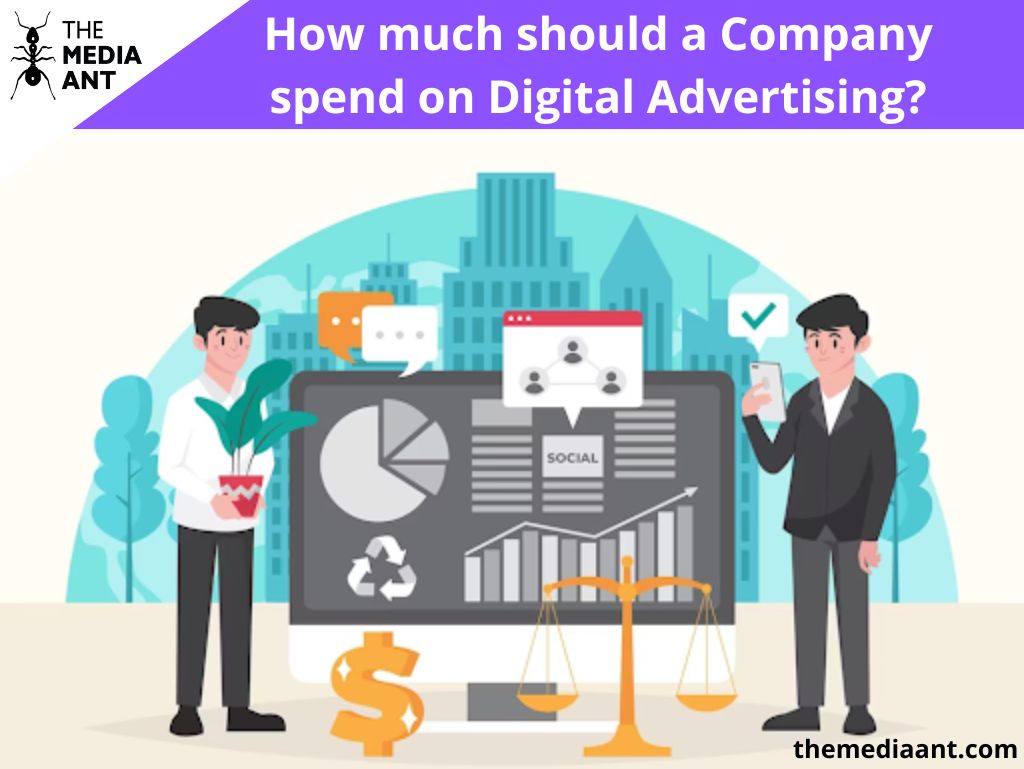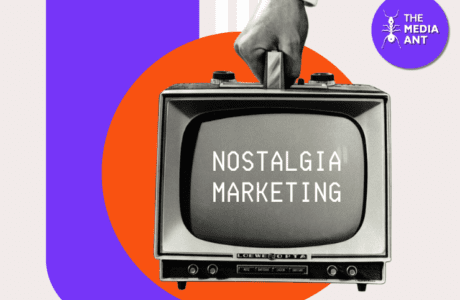Are you a business struggling to allocate a digital advertising budget for your brand? When trying to break down a budget there is no exact number but in this blog, we will be discussing the possible budget one can opt for on the basis of industry trends.
The amount a company should spend on digital advertising can vary widely depending on the industry, the company’s goals, and the target audience. There are different ways to approach budgeting for digital advertising, but a common method is to allocate a percentage of the company’s overall revenue towards advertising. The exact percentage can vary depending on the industry and the stage of the company’s growth. For example, a new startup may need to allocate a higher percentage of its revenue toward advertising to build brand awareness. In contrast, a more established company with a loyal customer base may only need to spend a little.
Another approach is to set a specific advertising budget based on the company’s goals and the advertising campaign’s expected return on investment (ROI ). This method involves calculating the expected revenue or other measurable benefits that the advertising campaign will generate and then setting a budget based on the expected ROI.
Ultimately, the amount a company should spend on digital advertising will depend on a variety of factors, and it’s important to approach budgeting for advertising strategically, based on the company’s specific needs and goals.
However, according to Gartner, the common rule of thumb is to allocate around 7-12% of total revenue for advertising purposes.
It’s important to note that this is just a general guideline, and companies should assess their specific needs and budgets to determine the appropriate amount to spend on digital advertising.
According to a report published by Dentsu, over the past two decades, Digital’s share of spending has jumped on average 3% points each year, but it accelerated during the pandemic in 2020 and 2021 when it increased by 5% points per year as consumer desire for online content to help fill the void of live experiences led to an explosion of demand. Digital’s share of spend is forecast to increase more slowly moving forwards, at 55.3% in 2022, it is predicted to reach 57.1% in 2023 and 58.2% in 2024.
How much are brands spending on digital across different Industries?
Fashion and Lifestyle
Example-Westside
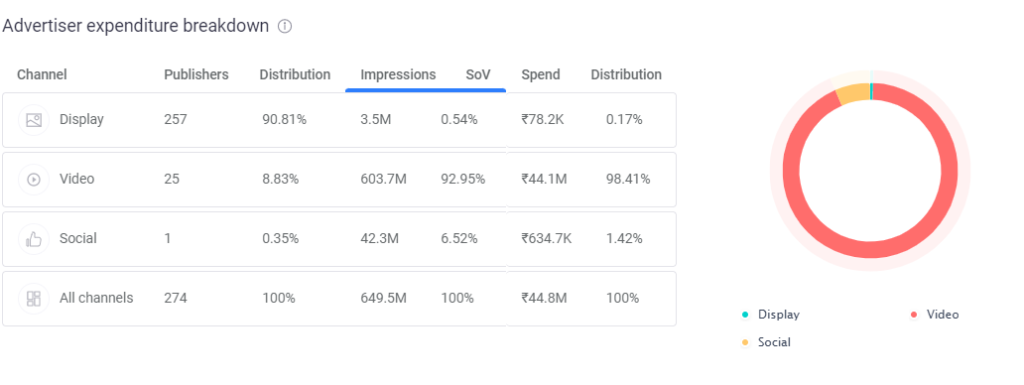
Based on the graphs provided, it can be inferred that Westside has invested INR 44.8M in digital advertising, resulting in 649.5M ad impressions in the last 12 months. The data also shows that the brand’s media-wise distribution of ad types is dominated by video ads, accounting for 92.95% of the total, followed by social media ads at 6.52%, and display ads at 0.54%. This indicates that Westside is heavily relying on video advertising to reach out to its target audience, which is a viable strategy for fashion and lifestyle brands to enhance their brand awareness and boost sales.
Therefore, for brands operating in this industry, allocating a significant portion of their digital advertising budget towards video ads can be a wise move. Video ads have the ability to captivate audiences and convey the essence of a brand’s identity, products, and services in an engaging manner. This not only helps in building brand awareness but also fosters deeper connections with the audience, leading to increased loyalty and higher sales.
E-commerce
Example-Firstcry


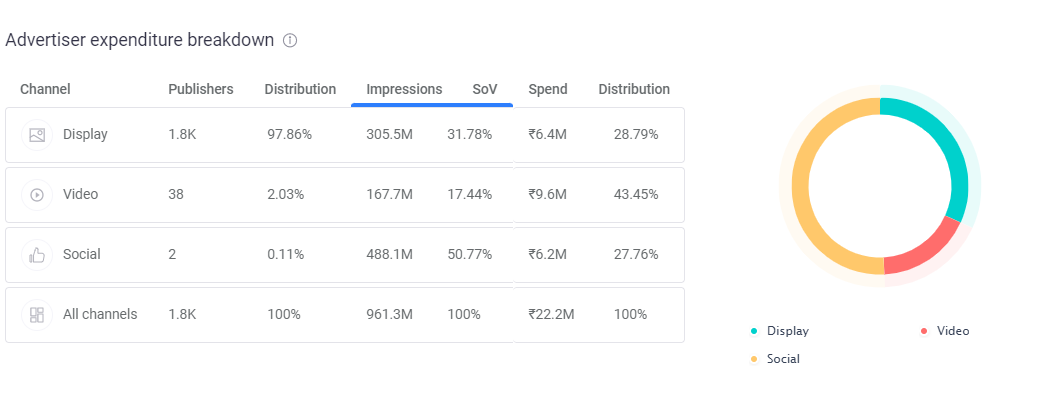
The graphs provided indicate that Firstcry has invested INR 22.2M in digital advertising, which resulted in 961.3M ad impressions in the last 12 months. The data also reveals that the brand’s media-wise distribution of ad types is primarily dominated by social media ads, accounting for 50.77% of the total, followed by banner ads at 31.78%, and video ads at 17.44%.
This shows that Firstcry is primarily focusing on social media ads to reach its target audience, which is an accurate strategy for e-commerce brands. With the increasing popularity of social media platforms, brands can leverage their vast user base to promote their products and services, which can lead to increased traffic, conversions, and revenue.
Moreover, the data also indicates that Firstcry is investing in banner ads, which can be an effective way to generate brand awareness and drive traffic to the website. However, video ads have a lower share of the brand’s digital advertising budget, which suggests that the brand may not be prioritizing this format for its marketing campaigns.
Overall, e-commerce brands looking to promote their products and services should consider investing in social media and banner ads, as these formats have shown to be effective in driving traffic and conversions. However, it is important to also explore other formats, such as video ads, to reach a wider audience and increase engagement.
Fintech
Example-CRED


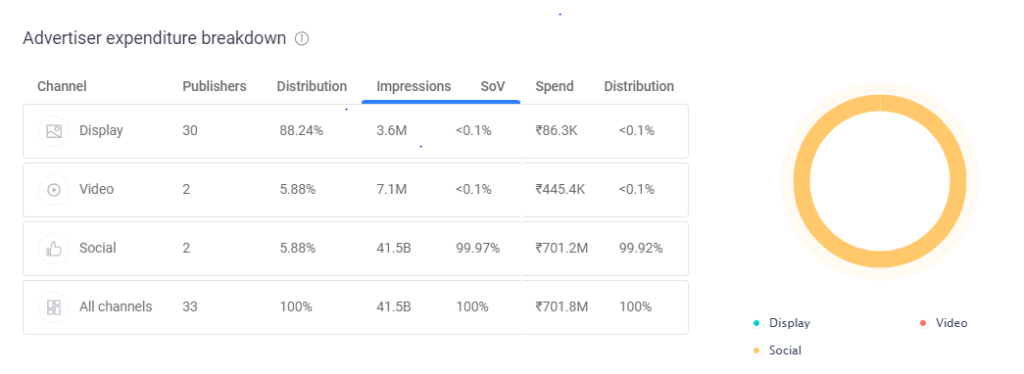
Based on the graphs provided, it can be inferred that CRED has allocated INR 701.8M towards digital advertising, resulting in 41.5B ad impressions in the last 12 months. The data also reveals that the brand’s media-wise distribution of ad types is primarily focused on social media ads, accounting for 99.97% of the total, followed by video ads at 0.02%, and banner ads at 0.01%.
This indicates that CRED is heavily investing in social media advertising to reach its target audience, which is a strategic move for fintech brands. With the increasing use of social media platforms for financial transactions and payments, fintech brands can leverage this trend to promote their services and increase their customer base.
Furthermore, the data also suggests that CRED is not prioritizing video and banner ads in its digital advertising strategy. This may indicate that the brand is focusing more on creating engaging content for social media platforms to attract and retain its target audience.
Overall, fintech brands looking to promote their services should consider investing in social media advertising as it is an effective way to reach their target audience. However, it is important to also explore other advertising formats to diversify the brand’s digital advertising strategy and reach a wider audience.
Fintech
Example-Groww


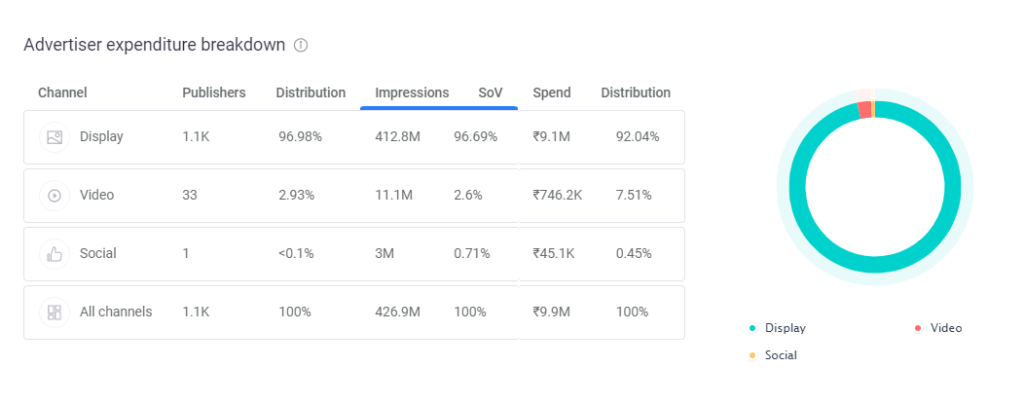
Based on the provided data, Groww has invested INR 9.9 million in digital advertising and received 426.9 million ad impressions. The majority of their advertising efforts are focused on display ads, which make up 96.69% of their media-wise distribution. Video ads make up 2.6% and banner ads make up 0.71%.
Given these numbers, it can be inferred that Groww’s advertising strategy has been successful in terms of reaching a large audience. Display ads can be an effective way to generate brand awareness and reach a broad audience. Video ads, while only a small percentage of their advertising budget, can be particularly effective in capturing viewers’ attention and delivering a clear message.
In the context of the finance industry, where trust and credibility are important factors, Groww’s emphasis on display and video ads can be seen as a wise choice. These types of ads allow the brand to showcase their expertise and communicate their value proposition to potential customers in a clear and engaging way.
Factors Affecting Digital Advertising Spend

There are several factors that can affect digital advertising spend, these include:
Business Objectives
The business objectives of an organization play a crucial role in determining the amount of money that should be allocated to digital advertising. The organization may spend more on display ads and social media campaigns if the primary goal is to increase brand awareness. If the objective is to drive sales, then more resources may be allocated to search engine advertising or affiliate marketing.
Target Audience
The target audience is another crucial factor that affects digital advertising spend. Organizations need to know who their audience is and what channels they prefer to use. For instance, if the target audience is mainly active on social media platforms, then the organization may need to invest more in social media advertising.
Ad Type
The type of ad being used can also affect the amount of money that should be spent on digital advertising. For instance, video ads tend to be more expensive than static banner ads or text-based ads. Therefore, organizations that want to use video ads may need to allocate more resources to their digital advertising budget.
Stage of Business
The stage of the business also plays a role in determining the amount of money that should be allocated to digital advertising. A new business may need to spend more on digital advertising to build brand awareness and attract new customers. Established businesses, on the other hand, may need to allocate more resources to retain existing customers and maintain their market share.
To summarize, the amount of money that an organization should spend on digital advertising depends on several factors, including business objectives, target audience, ad type, and stage of the business. Organizations need to carefully consider these factors when creating their digital advertising budget to ensure that they are getting the most out of their investment.
Cost of Digital Advertising

The cost of digital advertising can be affected by several factors, including the type of ad, the platform, the level of competition, and the target audience. Here are some key factors that can influence the cost of digital advertising:
Ad Type: The type of ad being used can impact the cost of digital advertising. Video ads, for example, tend to be more expensive than banner or text-based ads because of the resources required to create and distribute them.
Platform: Different digital advertising platforms have different pricing models, and costs can vary significantly. For instance, Facebook advertising typically uses a cost-per-click (CPC) or cost-per-impression (CPM) pricing model, while Google Ads uses a pay-per-click (PPC) model.
Competition: The level of competition in a particular industry can impact the cost of digital advertising. Highly competitive industries such as finance, insurance, and travel tend to have higher advertising costs due to the high demand for advertising space.
Target Audience: The target audience for a digital advertising campaign can also influence the cost. Advertising to a highly targeted audience can be more expensive than advertising to a broader audience, as the former requires more sophisticated targeting capabilities.
Geographic Location: The location of the target audience can also impact the cost of digital advertising. Advertising to a global audience is likely to be more expensive than advertising to a local audience, as global campaigns require more resources and a larger budget.
Overall, the cost of digital advertising can vary widely depending on the specific factors mentioned above. Businesses need to carefully consider these factors when creating their digital advertising budget to ensure that they are getting the most out of their investment.
Digital Advertising Agency
Looking to launch a digital advertising campaign in India? Look no further than The Media Ant! As a premier Google Partner, we have over 1200 digital media options at our fingertips, making us your one-stop shop for all your digital advertising needs.
We specialize in setting up and optimizing Google Search and Google Display campaigns, but we don’t stop there. Our team of experts can also help you place ads on other popular self-serve platforms like Facebook, LinkedIn, YouTube, and Quora.
And if that’s not enough, we’ve also partnered with all the top websites, M-sites, apps, and Facebook pages in India, ensuring you get the best digital advertising rates and discounts.
So, if you’re ready to take your digital advertising to the next level, contact The Media Ant today. We’re standing by to help you execute your digital advertising campaign with maximum effectiveness and efficiency. Simply send us an email at help@themediaant.com to get started.
FAQs Related to Digital Advertising Spend
How much do companies spend on digital ads?
The amount that companies spend on digital ads varies depending on their industry, business size, and advertising goals. According to eMarketer, the total digital ad spending in the United States was approximately $146.8 billion in 2020, and it is expected to increase to around $183.7 billion by 2024.
What is the ideal budget for digital ads?
The ideal budget for digital ads depends on several factors, including the company’s advertising goals, target audience, industry, and the type of ad being used. Companies should set a budget that aligns with their overall marketing strategy and ROI goals. It is also important to track the performance of digital ads and adjust the budget accordingly to optimize results.
Which industry spends the most on digital marketing?
The industries that spend the most on digital marketing vary depending on the year and the specific study. However, generally, industries with high competition for customer attention and those that heavily rely on online sales tend to have higher digital marketing budgets. For instance, industries such as retail, finance, and travel are known for spending significant amounts on digital marketing.
What are the uses of digital ad spend?
Digital ad spend can be used for various purposes, including increasing brand awareness, driving website traffic, generating leads, and increasing sales. Digital advertising can be used to target specific audiences, retarget users who have interacted with a company’s website or social media pages, and track the effectiveness of campaigns in real time. Digital ad spend can also be used for testing and optimizing ad campaigns to maximize their effectiveness.

